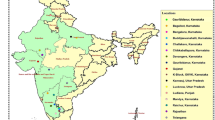Abstract
The development of sorghum anthracnose symptoms was monitored on 17 sorghum genotypes of diverse origins during two rainy seasons in the savanna of Nigeria. Four symptoms of the disease were clearly revealed by the sorghum differentials. The development of these symptoms was best studied in the local and exotic genotypes ‘Warwarabashi’ and ‘IS 18442’, respectively. The symptoms, which appeared in sequence and marked the different phases of the disease, include chlorotic flecks on leaves, necrotic spots on leaf lamina, leaf sheath lesion, midrib infection and panicle infection. Resistant genotypes produced only chlorotic flecks without acervuli, moderately resistant genotypes produced necrotic spots on the leaf lamina without noticeable acervuli while the susceptible genotypes had midrib and leaf lamina infections, which are the most severe symptoms accompanied by proliferous acervuli. The relationships of different phases are also discussed.
Zusammenfassung
Die Entwicklung von Anthraknosesymptomen an 17 Hirse-Genotypen unterschiedlicher Herkunft wurde wahrend zweier Regenperioden in der nigerianischen Savanne untersucht. Vier Krankheitssymptome konnten durch das Hirse-Testsortiment deutlich festgelegt werden. Als besonders geeignet fur die Untersuchung der Entwicklung der Symptome erwiesen sich die lokale Sorte ‘Warwarabashi’ und der exotische Genotyp ‘Is 18442’. Folgende Symptome, die in Folge erschienen und die verschiedenen Phasen der Krankheit darstellten, wurden beobachtet: chlorotische Flecken auf den Blättern, nekrotische Flecken auf den Blattflächen, Schäden an den Blattscheiden, Infektionen an den Mittelrippen und Rispen. An resistenten Genotypen bildeten sich nur chlorotische Flecken ohne Acervuli, mäßig resistente Genotypen produzierten nekrotische Flecken auf der Blattfläche ohne wahrnehmbare Acervuli, während sich an anfälligen Genotypen starke Befallssymptome und reichlich Acervuli auf den Mittelrippen und Blattflächen entwickelten. Die Beziehungen zwischen den verschiedenen Phasen der Krankheit werden diskutiert.
Similar content being viewed by others
References
Ali, M. E. K., H. L. Warren: Physiologic races of Colletotrichumgraminicola on sorghum. — Pl. dis. J. 71, 402–404, 1987.
Bailey, J. A, C. Nash, R. J. O’ Connell, R. A. Skipp: Infection process, host specificity and taxonomic relationship of a Colletotrichum species causing anthracnose disease of cowpea Vigna unguiculata. — Mycolog. Res. 94, 810–814, 1990.
Bailey, J. A., M. J. Jegger: In: Colletotrichum: Biology, pathology and control. C. A. B. International, Wallingford, pp. 381, 1992.
BOSADP: Borno State Agricultural Development Programme Cropping Recommendations. — Publication of the Borno State Agricultural Development Programme, Nigeria. pp. 1–31 1989.
Dargent, R., A. T ouze: Etude cinetigue, en microscope electronique, des interactions Colletotrichum lagenarium et les cellules foliaires de Cucumis mello. — Canad. J. Bot. 52, 1319–1323, 1974.
Frederiksen, R. A.: Disease problems. — In: Sorghum, Proceedings of the International Workshop on Sorghum Diseases, ICRISAT, p. 331. Hyderabad, Patancheru, India, 1981.
Nicholson, R. L., H. L. Warren: Criteria for evaluation to maize anthracnose. — Phytopathology 66, 86–90, 1976.
O’ Connell, R. J., J. A. Bailey: Cellular interactions between Phaseolus vulgaris and hemibiotroph Colletotrichum indeuthianum. — In: BAILEY, J. A. (ed.): Biology and molecular biology of plant- pathogen interaction. pp. 39–48. Springer-Verlag, Berlin, 1986.
Pande, R., R. Harikrishnan, M. D. Alegbejo, L. K. Maghogho, O. Ajayi: Prevalence of sorghum disease in Nigeria. — Internat. J. Pest Managem. 39, 297–303, 1993.
Pastor-Corales, M. A., R. A. Frederiksen: Sorghum anthracnose. — In: Sorghum disease: A world review. Proceedings of the International Workshop on Sorghum Diseases, Icrisat, pp. 289–294. Hyderabad, Patancheru, India, 1980.
Powell, P., M. E llis, A. M. Alamed, A. Sotomayar: Effect of natural epiphytotic on yield, grain quality, seed health and seed-borne fungi in sorghum bicolor. — Sorghum Newsletter 20, 77–78, 1977.
Thomas, M. D.: Sorghum disease in Western Africa. — In: Sorghum and millet diseases. A second World Review. Proceedings of the International Workshop on Sorghum Diseases, Icrisat, pp. 25–28. Hyderabad, Patancheru, India, 1992.
Author information
Authors and Affiliations
Rights and permissions
About this article
Cite this article
Gwary, D.M., Rabo, T.D. & Anaso, A.B. The development of anthracnose symptoms on sorghum genotypes in the Nigerian savanna. J Plant Dis Prot 111, 96–103 (2004). https://doi.org/10.1007/BF03356136
Received:
Accepted:
Published:
Issue Date:
DOI: https://doi.org/10.1007/BF03356136




